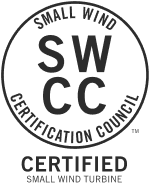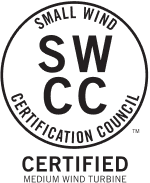[carousel_slide id='4083']


(1) American Wind Energy Association (AWEA) Small Wind Turbine Performance and Safety Standard 9.1-2009; or
(2) International Electrotechnical Commission (IEC) 61400-1, 61400-12, and 61400-11.
According to the current IRS Notice, the certification must be issued by an eligible certifier - defined as a third party that is accredited by the American Association for Laboratory Accreditation or other similar accreditation body. Documentation establishing that the turbine meets the new requirements must be provided to taxpayers in order to claim the credit. ICC-SWCC certifications help manufacturers meet these requirements. An April 2014 memorandum from the Director of the U.S. Department of Energy's Wind and Water Power Technologies Office, also encourages that the use of public funds be provided only for wind turbines that have been tested and certified for safety, function, performance, and durability. Notice 2015-4 is posted at: http://www.irs.gov/pub/irs-drop/n-15-04.pdf. The notice reminds manufacturers that an erroneous certification may result in penalties: (a) Under section 7206 for fraud and making false statements; and (b) Under section 6701 for aiding and abetting an understatement of tax liability ($1,000 per return on which a credit is claimed in reliance on the certification). Disclaimer: All opinions and other postings, are offered for informational purposes only and should not be construed as legal or tax advice. You should consult directly with an attorney or accountant for individual advice regarding your particular situation.(1) American Wind Energy Association (AWEA) Small Wind Turbine Performance and Safety Standard 9.1-2009; or
(2) International Electrotechnical Commission (IEC) 61400-1, 61400-12, and 61400-11.
According to the current IRS Notice, the certification must be issued by an eligible certifier - defined as a third party that is accredited by the American Association for Laboratory Accreditation or other similar accreditation body. Documentation establishing that the turbine meets the new requirements must be provided to taxpayers in order to claim the credit. ICC-SWCC certifications help manufacturers meet these requirements. An April 2014 memorandum from the Director of the U.S. Department of Energy's Wind and Water Power Technologies Office, also encourages that the use of public funds be provided only for wind turbines that have been tested and certified for safety, function, performance, and durability. Notice 2015-4 is posted at: http://www.irs.gov/pub/irs-drop/n-15-04.pdf. The notice reminds manufacturers that an erroneous certification may result in penalties: (a) Under section 7206 for fraud and making false statements; and (b) Under section 6701 for aiding and abetting an understatement of tax liability ($1,000 per return on which a credit is claimed in reliance on the certification). Disclaimer: All opinions and other postings, are offered for informational purposes only and should not be construed as legal or tax advice. You should consult directly with an attorney or accountant for individual advice regarding your particular situation.